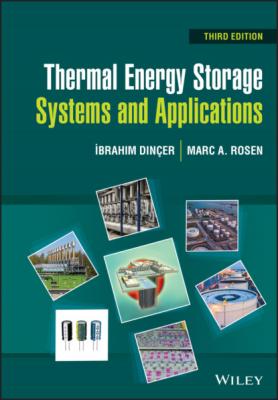Thermal Energy Storage Systems and Applications. Ibrahim Dincer
Читать онлайн.| Название | Thermal Energy Storage Systems and Applications |
|---|---|
| Автор произведения | Ibrahim Dincer |
| Жанр | Физика |
| Серия | |
| Издательство | Физика |
| Год выпуска | 0 |
| isbn | 9781119713142 |
The continuity equation is based on the conservation of mass principle. The requirement that mass be conserved at every point in a flowing fluid imposes certain restrictions on the velocity u and density ρ. Therefore, the rate of mass change is zero, so that for a steady flow, the mass of fluid in the control volume remains constant, and therefore the mass of fluid entering per unit time is equal to the mass of fluid exiting per unit time. We now apply this idea to a steady flow in a stream tube (Figure 1.8). The continuity equation for the flow of a compressible fluid through a stream tube is
Figure 1.8 Fluid flow in a stream tube.
where ρ1δA1u1 is the mass entering per unit time (at section 1) and ρ2δA2u2 is the mass exiting per unit time (at section 2).
In practice, for the flow of a real fluid through a pipe or a conduit, the mean velocity is used since the velocity varies from wall to wall. Then, Eq. (1.46) can be rewritten as
where
For fluids that are considered as incompressible, Eq. (1.47) is simplified to the following, since ρ1 = ρ2:
(1.48)
The various forms of the continuity equation for steady‐state and unsteady‐state cases are summarized below:
The steady‐state continuity equation for an incompressible fluid in a stream tube:(1.49)
The unsteady‐state continuity equation for an incompressible fluid in a stream tube:(1.50)
The steady‐state continuity equation for an incompressible fluid in cartesian coordinates:(1.51)
The unsteady‐state continuity equation for an incompressible fluid in cartesian coordinates:(1.52)
The steady‐state continuity equation for an incompressible fluid in cylindrical coordinates:(1.53)
The steady‐state continuity equation for a compressible fluid in a stream tube:(1.54)
The steady‐state continuity equation for a compressible fluid in cartesian coordinates:(1.55)
The steady‐state continuity equation for a compressible fluid in cylindrical coordinates:(1.56)
The unsteady‐state continuity equation for a compressible fluid in a stream tube:(1.57)
The unsteady‐state continuity equation for a compressible fluid in cartesian coordinates:(1.58)
The unsteady‐state continuity equation for a compressible fluid in cylindrical coordinates:(1.59)
(b) Momentum Equation
The analysis of fluid‐flow phenomena is fundamentally dependent on the application of Newton's second law of motion, which is more general than the momentum principle, stating that when the net external force acting on a system is zero, the linear momentum of the system in the direction of the force is conserved in both magnitude and direction (the so‐called conservation of linear momentum). In fact, the momentum principle is concerned only with external forces, and provides useful results in many situations without requiring much information on the internal processes within the fluid. The momentum principle finds applications in various types of flows (e.g. steady or unsteady, compressible or incompressible).
The motion of a particle must be described relative to an inertial coordinate frame. The one‐dimensional momentum equation at constant velocity can be written as follows:
where ∑F stands for the sum of the external forces acting on the fluid, and mV stands for the kinetic momentum in that direction. Equation (1.60) states that the time rate of change of the linear momentum of the system in the direction of V equals the resultant of all forces acting on the system in the direction of V. The linear momentum equation is a vector equation and is therefore dependent on a set of coordinate directions.
The rate of change of momentum of a control mass can be related to the rate of change of momentum of a control volume via the continuity equation. Then, Eq. (1.60) becomes
(1.61)
Here, the sum of forces acting on the control volume in any direction is equal to the rate of change of momentum of the control volume in that direction plus the net rate of momentum flux from the control volume through its control surface in the same direction.
For a steady flow, if the velocity across the control surface is constant, the momentum equation in scalar form becomes
If the mass flow rate
(1.63)
Similar expressions can be written for the y and z directions.
(c) Euler's Equation
Euler's equation is a mathematical statement of Newton's second law of motion, and finds application in an inviscid fluid continuum. This equation states that the product of mass and acceleration of a fluid particle can be equated vectorially with the external forces acting on the particle. Consider a stream tube, as shown in Figure 1.9, with a cross‐sectional area small enough for the velocity to be considered constant along the tube.
The
